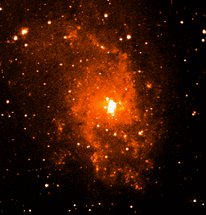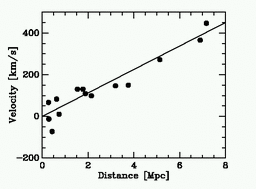|
The Universe is not only getting bigger, it also seems to be
accelerating, according to a variety of recent measurements of objects
at great distance from the Earth. The measurements imply that a new
form of energy, dubbed "dark energy", acts as a kind of anti-gravity
and presently has the effect of causing the universe to expand at an
ever increasing rate.
The dark energy is thought to operate on the Universe's very
largest scales, but what about closer to home? Are there effects on
nearby galaxies caused by the dark energy? Astronomers Arthur
Chernin, Pekka Teerikorpi and Yuri Baryshev, who
work at Tuorla Observatory, think that there is, and it may explain
why Edwin Hubble was even able to detect and discover the famous
expansion of the Universe using galaxies which are relatively close to
home.
Edwin Hubble discovered the expansion of the Universe in the
1920s, by measuring the speeds at which galaxies at a range of
distances from the Milky Way were moving. He found that the further
the galaxy, the faster it appeared to be moving away from us. This
general effect has now been confirmed for thousands of galaxies out to
very great distances indeed.
In retrospect, his discovery holds another surprise: how was he
able to make it with galaxies quite close to the Milky Way?
Simulations of how the galaxies near the Milky Way would behave in an
expanding universe, in which the mutual gravity of the galaxies
controls the motions, have shown that most galaxies would pick up
quite a lot of extra speed over the lifetime of the Universe. The
simulations show that, for galaxies around a small group of galaxies
like our own, the amount of randomness in the velocities can be so
large as to render their general outward flow difficult to see at all;
and certainly difficult to see with the small number of galaxies
available to Hubble.
Instead, in galaxies around us, the Hubble flow is seen starting from about 1-2
Mpc (3 to 6 million light years) away and is seen, onwards and outwards, as far
as one cares to look. Why is it that the Hubble flow can be seen so easily,
even so close by?
Baryshev, Chernin and Teerikorpi are addressing this problem at Tuorla
Observatory. They write down the equations of motion in the presence
of dark energy -- adding in a repulsive term. The relative strength of
this term is depends upon the local density of matter; there is a
zero-gravity radius (ZGR) around the local group at about 2 Mpc --
beyond this the expansion and repulsion terms dominate. The effect of
the repulsion term in the equations is to "cool" the outer parts of
groups, so that galaxies which would otherwise flow in instead
"condense" onto the Hubble flow. This means the the Hubble flow can be
recognised at rather short distances from small groups, and makes the
scatter around the flow small as well. Back of the envelope
computations with dark energy included are able to reduce the scatter
in the flow to 40 to 100 km/s, consistent with observations.
The reason the dark energy was not thought to have nearby effects can
be understood as well. On large scales, for the Universe as a whole,
the accelerating effect of the dark energy only began to operate a few
billion years ago, when it was able to overcome the decellerating
effect of the large scale matter distribution. However, the time that
the dark energy has had to act is longer in regions with a density
contrast like the local group of galaxies. In such environments, the
dark energy has had considerably longer to act and we can see its
effects quite easily. In fact, it may be the very reason Hubble was
able to detect the expansion of the Universe with relative ease so
long ago!
Last update: June 28th, 2004.
|
|
 Image of the nearby
galaxy M33, which is near the edge of the local group of
galaxies. Credit: Tuorla 0.7 meter Schmidt Telescope, Seppo
Katajainen
 The plot shows the Hubble
law in the environment of the Local Group of galaxies, demonstrating
how the velocity and distance of galaxies are tightly correlated. The
galaxies in this diagram all have distances measured using the best
available method based on Cepheid type stars. The Hubble flow, or
general expansion of the universe discovered by Edwin Hubble in the
1920's, appears immedeately beyond the edge of the Local Group, at
about 1.5 Mpc from our Milky Way. The scatter around the linear,
smoothly flowing relation, is remarkably small and may have an
explanation in terms of nearby effects of the "dark energy" which has
only recently been discovered. Plot credit: Pekka Teerikorpi.
|
